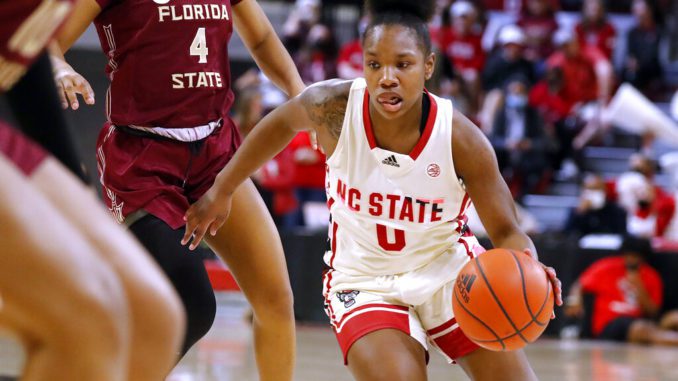
We’re about to go on a journey.
We’ve heard a lot about our destination, but most of us have never seen this strange, foreign territory.
“I’m not sure I’m supposed to be talking about this,” said NC State women’s basketball player Diamond Johnson, with a nervous laugh.
Johnson is one of the college athletes who have gone to this mysterious place by the thousands in recent years. But most of the rest of us don’t even know what it looks like.
The place is the NCAA transfer portal. And while most athletes return from their trip there and many even thrive, the portal is an unseen land. Parts unknown. Here there be dragons.
Join me, as we head into the portal.
Not what you think
As with any place shrouded in mystery, the portal is probably not how you imagine it.
The portal was developed in 2018 to give college athletes more freedom. They no longer need to get their coach’s permission before changing schools, and that has led to what many call free agency in college athletics.
More than 2,000 football players and 1,400 basketball players went through the portal over the past year. More than half of the 60 players representing their teams at the recent ACC men’s and women’s basketball media days in Charlotte had used it to change schools at least once — and more than a few had made multiple trips.

It’s easy to get the impression that the portal is a secret website that athletes can head to whenever they get yelled at by Coach in practice or spend too much time on the bench in a game. Many of us unfamiliars may have visions of an angry player, sitting in a dorm room with the cursor hovering over the “transfer now” button, wondering if today is the day they click it.
For the most part, however, athletes don’t have access to the portal.
“When you use the portal, you have to go to the compliance office,” said Cameron Swartz, a Georgia Tech women’s player by way of Boston College and Colorado.
Compliance is the department that makes sure a college abides by NCAA rules. They hold the keys to the portal for an athlete looking to roam.
Since compliance is driving the process, there’s no “welcome to the portal” message on the website — just menu options.
“It’s just ‘get down to business,’” said Swartz. “It’s just a list. It’s a very, very fast process. Very intense.”
“You have to answer some questions,” said Johnson, a Wolfpack player by way of Rutgers. “You choose whether you want to be contacted by coaches and how you want them to contact you.”
“You had to go talk to compliance and, like, let them know,” said Bianca Jackson, Swartz’s teammate at Georgia Tech, by way of Florida State and South Carolina. “So compliance kind of presses the button for you.”
Some players remember seeing the “are you sure” warning message on the screen after the button is pushed. Others don’t have that recollection. That may be because of the portal’s next big secret: You may not enter it when you think you do.
After an athlete tells them he or she wants to transfer, compliance offices have up to 48 business hours to actually enter them into the portal. So it may not happen while the player is sitting there in the office. Often, a compliance officer will recommend that the player talk to the coach and give him or her the chance to change their mind.
“They’ve given you everything you should give them their respect,” Swartz said, echoing the message compliance gives many athletes.
Compliance doesn’t always take the 48 hours. It seems to be on a case-by-case basis. Some athletes reported that they began hearing from coaches immediately. Johnson said she returned to the office to temporarily change her response to a “do not contact” after getting swamped with calls. Others, like Reigan Richardson — a Duke Blue Devil by way of Georgia — said it was “a couple of days” before she heard from anyone, likely because of a delay by compliance in entering her in the portal.
That creates a problem for the other group of frequent portal visitors: The coaches.
The other side of the portal
Every coach wants to be the first to contact a prime transfer target, but contacting them before they’re officially in the portal is a rules violation.
“Mostly, social media tells you about who’s in the portal,” said NC State men’s coach Kevin Keatts. “A kid is tweeting, and then (the media) find out and tweet about it. Then before we make any calls, we have to go and check to make sure they’re actually in the portal.”
Other coaches take a different approach.
“It’s not like (high school) recruitment, where you get to know a kid,” Pitt’s Jeff Capel said. “It’s more like speed dating.”
As a result, coaches need to get ahold of a player fast — before they get overwhelmed and ask compliance to change to “do not contact,” a status marked on the coach’s portal site by a bright red yield sign next to the player’s name. (There are also graduation cap icons to denote which players are grad transfers)
“It’s pretty much immediate that they contact you,” said Jacob Grandison, who joined the Blue Devils after playing at both Illinois and Holy Cross. “There’s somebody on staff watching that portal at every school.”
Capel said he had to organize coverage of the portal.
“I don’t think we were equipped last year to handle the transfer portal as a staff,” he said, “and that’s on us. I thought we were more prepared for it this year.”
It shows. Seven of the 15 players on Pitt’s roster are transfers.
“I think you have to have one person on the staff that’s dedicated, that’s constantly just looking,” Capel said. “I don’t think at our level that can be just an assistant coach because you have so many other responsibilities.”
That includes hitting the most important button on the portal site — the refresh button. One area of frustration for coaches is that the site does not update automatically. You have to keep refreshing the screen to see new entries. During busy times, like immediately following a season, each click of refresh brings a new crop of names.
Each of those names represents someone who took the trip to the compliance office and sat there, contemplating the question on the screen: “Are you sure you want to transfer?”
“It’s a scary moment,” Swartz said, “but it’s a risk that you got to take for a better path for yourself.”


